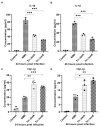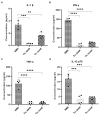Role of Type 4B Secretion System Protein, IcmE, in the Pathogenesis of Coxiella burnetii
- PMID: 38787259
- PMCID: PMC11123719
- DOI: 10.3390/pathogens13050405
Role of Type 4B Secretion System Protein, IcmE, in the Pathogenesis of Coxiella burnetii
Abstract
Coxiella burnetii is an obligate intracellular Gram-negative bacterium that causes Q fever, a life-threatening zoonotic disease. C. burnetii replicates within an acidified parasitophorous vacuole derived from the host lysosome. The ability of C. burnetii to replicate and achieve successful intracellular life in the cell cytosol is vastly dependent on the Dot/Icm type 4B secretion system (T4SSB). Although several T4SSB effector proteins have been shown to be important for C. burnetii virulence and intracellular replication, the role of the icmE protein in the host-C. burnetii interaction has not been investigated. In this study, we generated a C. burnetii Nine Mile Phase II (NMII) mutant library and identified 146 transposon mutants with a single transposon insertion. Transposon mutagenesis screening revealed that disruption of icmE gene resulted in the attenuation of C. burnetii NMII virulence in SCID mice. ELISA analysis indicated that the levels of pro-inflammatory cytokines, including interleukin-1β, IFN-γ, TNF-α, and IL-12p70, in serum from Tn::icmE mutant-infected SCID mice were significantly lower than those in serum from wild-type (WT) NMII-infected mice. Additionally, Tn::icmE mutant bacteria were unable to replicate in mouse bone marrow-derived macrophages (MBMDM) and human macrophage-like cells (THP-1). Immunoblotting results showed that the Tn::icmE mutant failed to activate inflammasome components such as IL-1β, caspase 1, and gasdermin-D in THP-1 macrophages. Collectively, these results suggest that the icmE protein may play a vital role in C. burnetii virulence, intracellular replication, and activation of inflammasome mediators during NMII infection.
Keywords: Coxiella burnetii; caspase 1; cytokines; icmE protein; inflammasome; pyroptosis; type IV secretion system; virulence.
Conflict of interest statement
The authors declare no conflicts of interest.
Figures







Similar articles
-
Dot/Icm-Translocated Proteins Important for Biogenesis of the Coxiella burnetii-Containing Vacuole Identified by Screening of an Effector Mutant Sublibrary.Infect Immun. 2018 Mar 22;86(4):e00758-17. doi: 10.1128/IAI.00758-17. Print 2018 Apr. Infect Immun. 2018. PMID: 29339460 Free PMC article.
-
A screen of Coxiella burnetii mutants reveals important roles for Dot/Icm effectors and host autophagy in vacuole biogenesis.PLoS Pathog. 2014 Jul 31;10(7):e1004286. doi: 10.1371/journal.ppat.1004286. eCollection 2014 Jul. PLoS Pathog. 2014. PMID: 25080348 Free PMC article.
-
Dot/Icm type IVB secretion system requirements for Coxiella burnetii growth in human macrophages.mBio. 2011 Sep 1;2(4):e00175-11. doi: 10.1128/mBio.00175-11. Print 2011. mBio. 2011. PMID: 21862628 Free PMC article.
-
Intracellular life of Coxiella burnetii in macrophages.Ann N Y Acad Sci. 2009 May;1166:55-66. doi: 10.1111/j.1749-6632.2009.04515.x. Ann N Y Acad Sci. 2009. PMID: 19538264 Review.
-
Right on Q: genetics begin to unravel Coxiella burnetii host cell interactions.Future Microbiol. 2016 Jul;11(7):919-39. doi: 10.2217/fmb-2016-0044. Epub 2016 Jul 15. Future Microbiol. 2016. PMID: 27418426 Free PMC article. Review.
Cited by
-
Navigating Q fever: Current perspectives and challenges in outbreak preparedness.Open Vet J. 2024 Oct;14(10):2509-2524. doi: 10.5455/OVJ.2024.v14.i10.2. Epub 2024 Oct 31. Open Vet J. 2024. PMID: 39545195 Free PMC article. Review.
References
-
- CDC . Q Fever. Centers for Disease Control and Prevention; Antlanta, GA, USA: 2019. [(accessed on 25 June 2023)]. Available online: https://www.cdc.gov/qfever/
MeSH terms
Substances
Grants and funding
LinkOut - more resources
Full Text Sources

